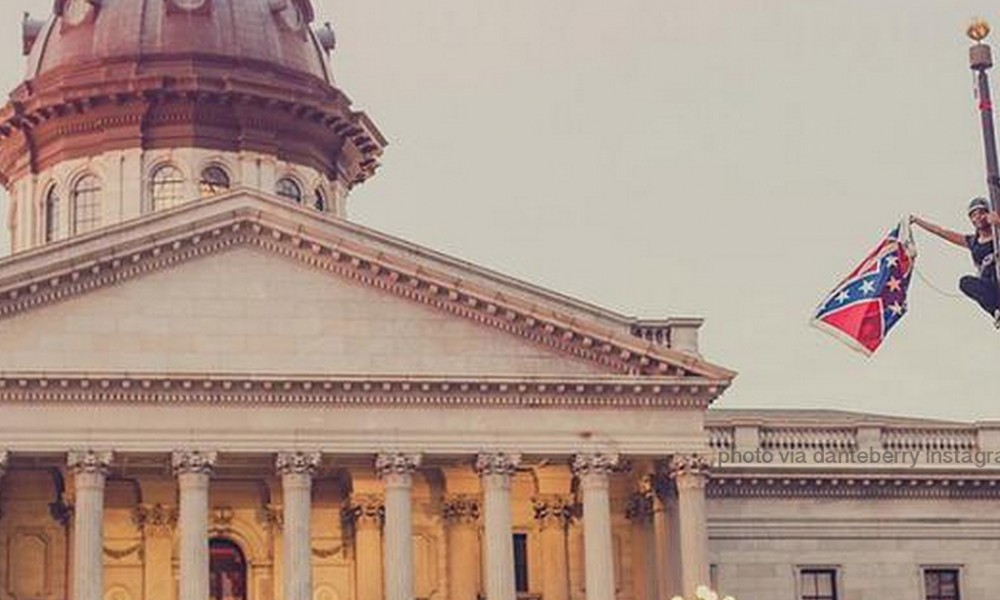“What Does ______ Have to Do with Rainforests?!”
This week, RAN posted a message of support on Facebook about the courageous civil disobedience by Bree Newsome in South Carolina. And, as a testament to the social justice leanings of our community, our post was met with predominant support.
However, there was also the de rigeur Internet Indignance.
“Why is an environmental group talking about ____?” “What does this have to do with rainforests?!!” “You no longer have my support!” We always expect these responses.
Yet when we touch on issues involving race in the United States, those responses always seem a little louder. And a lot uglier.
Systems Change: It’s What We Do
Of course, Rainforest Action Network is no stranger to civil disobedience or controversy. For 30 years, one of RAN’s core advocacy strategies has been to challenge corporate power and systems of injustice through peaceful direct action. Draping banners on skyscrapers, activists locking down in corporate headquarters, street blockades — bringing intense public pressure onto the worst of the worst offenders has proven very effective over the years. And while we are most widely associated with environmental advocacy, our work over the past three decades has always been focused against corrupted institutional forces that are responsible for the climate change crisis and rampant human rights violations.
Quite frankly that’s why I work here. Because we as an organization take a macro view of problems in the world and find the levers of change we can grab and, with the weight of justice as our advantage, shift systems.
For us here at RAN, social justice has never been an “extra.” It’s fundamental. It’s a “Yes, and..”.
Yes we work on the rainforest, and climate change, and the financial systems that fuel destruction, and natural places and their inhabitants around the globe. And… a huge factor in those fights is the systemic disregard for laborer rights — that’s an intentional part of the profit margin for corporations destroying rainforests. And… the theft of traditional lands and displacement of Indigenous peoples is treated as a given, otherwise how could market demand be satisfied? And… forced labor is an allowable risk for massive, global brands, as long as there’s plausible deniability and a murky supply chain that provides cover for makers of chips and ice cream and kids snacks.
These are our fights, too. These are the human rights issues that are fundamental to our work at RAN. They are non-negotiable. They are deal breakers. If corporations that we target do not acknowledge and address these issues, we continue to campaign and shine a light on their actions until they do.
What does racism have to do with your work?
With that as our history and the baseline of our programmatic commitment, we naturally reach out to support those who are fighting systems of injustice here in the United States. And institutional racism is the most entrenched system of oppression and inequality in U.S. history. Here is a good breakdown from Colorlines about the multiple layers of racism in the United States today:
Whether it be another attempt to force a pipeline across a First Nation’s community without consent or the stark reality that in the US “sacrifice zones” disproportionately impact communities of color <link >. These are just two examples of a long list of ways in which a system that is built on multiple layers of racism plays itself out with a negative and deadly impact at the intersections of the environment and humans rights.
I could try to explain how individual acts of civil disobedience can create a larger, ripple effect, but in context Bree Newsome is the best person to explain:
“We discussed it and decided to remove the flag immediately, both as an act of civil disobedience and as a demonstration of the power people have when we work together. Achieving this would require many roles, including someone who must volunteer to scale the pole and remove the flag. It was decided that this role should go to a black woman and that a white man should be the one to help her over the fence as a sign that our alliance transcended both racial and gender divides. We made this decision because for us, this is not simply about a flag, but rather it is about abolishing the spirit of hatred and oppression in all its forms.
I removed the flag not only in defiance of those who enslaved my ancestors in the southern United States, but also in defiance of the oppression that continues against black people globally in 2015, including the ongoing ethnic cleansing in the Dominican Republic. I did it in solidarity with the South African students who toppled a statue of the white supremacist, colonialist Cecil Rhodes. I did it for all the fierce black women on the front lines of the movement and for all the little black girls who are watching us. I did it because I am free.
To all those who might label me an “outside agitator,” I say to you that humanitarianism has no borders. I am a global citizen. My prayers are with the poor, the afflicted and the oppressed everywhere in the world, as Christ instructs. If this act of disobedience can also serve as a symbol to other peoples’ struggles against oppression or as a symbol of victory over fear and hate, then I know all the more that I did the right thing”
Read more: EXCLUSIVE: Bree Newsome Speaks For The First Time After Courageous Act of Civil Disobedience
So whether it be Bree scaling the flag pole, sit-ins in federal buildings, or blocking the arctic drilling rigs in Seattle, it is all linked. It as part of a theory of systems change. A collective effort to change from a system of oppression, othering, and extraction to a system of justice, inclusion, and equity.
For people and planet,
Brad A Schenck – @BradASchenck
Digital Engagement Director

